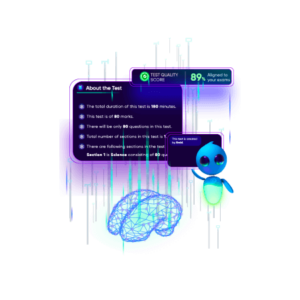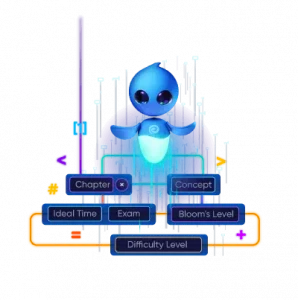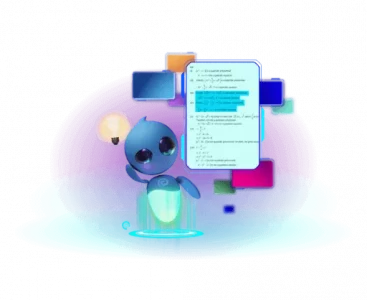You Can Score Higher
19,575,323
LEARNING OUTCOMES DELIVERED
There is no AI without data :)
Some say they do it. It’s taken us 8 years
We work on exciting and intuitive tech every day to deliver next-generation learning to our users. Experience these powerful tools for yourself and see how we do what we do.

Get ready to ace your exams with our cutting-edge Auto Test Generation tool. Whether you are preparing for competitive exams or school tests, our platform allows you to generate personalised tests with maximum customisation quickly. With our advanced Test Quality Score algorithm, you can be assured of high-quality questions that accurately assess your knowledge. With the Create Your Own Test feature, you can select specific chapters and difficulty levels for specific goals and exams to create personalised tests tailored to….
Explore
Say goodbye to Math anxiety with Instasolver–the revolutionary AI-powered platform that provides instant step-by-step solutions to complex Math problems. Our cutting-edge platform uses advanced deep-learning language models and is trained on a vast math data corpus to provide accurate solutions at lightning speed. Solving mathematical word problems is no easy feat. It requires solving complex mathematical concepts and understanding and interpreting the natural language to formulate the computational graph of mathematical concepts. Embibe’s content intelligence stack has more than 2000….
Explore
No more struggling with doubts on your own! Our AI-powered platform is designed to help you resolve your queries quickly and easily. Whether you’re struggling with a difficult concept or need clarification on a particular topic, our platform connects you with the expert assistance you need to succeed instantly. Start using Embibe’s Doubt Resolution solution today! Millions of students nationwide use Embibe regularly to learn more, practice hard and test themselves to achieve learning outcomes. Throughout this journey, it is….
Explore
Our innovative tool, MetaTags Ranker, is designed specifically for subject matter experts, providing them with comprehensive suggestions for tagging any given question’s subject, unit, chapter, topic, and concept. This powerful tool also offers suggestions for the question’s difficulty level, ideal time, and bloom level, making creating high-quality content that meets students’ goals easier than ever. In the field of Education Technology, one of the important tasks is to make content accessible and discoverable for all users. In order to do….
Explore
Empower Your Learning with Knowledge Buddy. Our Knowledge Buddy tool is an intelligent chatbot that uses the power of Artificial Intelligence to help students revise their learning and resolve their doubts in real-time. It also answers students’ questions while they engage with learning content, providing them with immediate feedback and support. At Embibe, we are committed to empowering students’ learning journey. Knowledge Buddy is an Artificial Intelligence chatbot built to help students revise their learnings using question answering and doubt….
Explore
Discover the power of Embibe’s MEDHAS platform, the next level of learning and assessment technology! Our cutting-edge platform leverages the latest natural language understanding (NLU) technology advancements to provide hyper-tagged learning and assessment content, contextualised knowledge graphs, and interpretable predictions that enable personalised and adaptive learning experiences. Medhas, a Sanskrit word, means knowledge, understanding and intelligence. Natural language understanding (NLU) platform is very important to build an EdTech AI platform. NLU capabilities enable hyper-tagged learning and assessment content, contextualized knowledge….
Explore
We understand every student is different, with their unique learning style, pace, and preferences. That’s why our platform is designed to analyse your performance and provide targeted learning resources to help you improve your skills and knowledge. Embark on a personalised achievement journey with Artificial Intelligence in education to identify your strengths and weaknesses and learn more efficiently. Personalised Achievement Journey (PAJ) aims to provide an optimal learning path to a student given their current knowledge level, a predefined time….
Explore
Unlock new horizons of learning outcomes with our Translation tool to access a wide range of learning materials in your preferred language. Our advanced Neural Machine Translation technology is infused with human intelligence and Artificial Intelligence to provide accurate translations in real-time. Embibe is an AI platform for delivering learning outcomes at scale [5][6]. We are committed to students all across the world, studying in any language. The translation project aims to provide educational content in vernacular languages to millions….
ExplorePatent & Research Highlights
45 Publications and 13 Patents
Automatic Ingestion of Content from Unstructured Data Sources
Read MoreIdentifying Student Learning Styles
Read MoreExtracting Semantic and Context Information from Images and Equations
Read MoreAutomated Evaluation of Free Text Answer based Questions
Read MoreSmart Tagging – Towards Intelligent Content
Read MoreEffects of Student Behaviour on Learning Outcomes
Read MoreEmbibe Score Quotient: Machine Learning for Outcomes Improvement
Read MoreIntelligent Content Ingestion
Read MoreFrequently Asked Questions
What is AI in education?
AI in education refers to the use of artificial intelligence technologies to enhance learning and teaching experiences. This can include applications such as intelligent tutoring systems, which provide personalised feedback and guidance to students, as well as adaptive learning platforms that adjust content and delivery based on the individual learner’s needs.
How can AI improve the learning experience?
AI can improve the learning experience by providing personalised feedback, adaptive learning, and access to educational resources. It can also assist with administrative tasks, such as grading, and help educators gain insights into student performance and areas for improvement.
How is AI being used in education?
AI is being used in education in various ways, including intelligent tutoring systems, chatbots for student support, personalised learning platforms, automated grading and feedback, plagiarism detection tools, and predictive analytics for student performance. AI can also be used to assist with administrative tasks, such as scheduling and resource allocation.
What are the benefits of using AI in education?
The benefits of using AI in education include personalised learning experiences, enhanced student engagement and motivation, improved student outcomes, and increased efficiency in administrative tasks. AI can also provide educators with insights into student performance and areas for improvement, allowing them to tailor their teaching strategies accordingly. Additionally, AI can offer students access to educational resources and support outside of traditional classroom hours, expanding their learning opportunities.
What are the potential drawbacks of using AI in education?
The potential drawbacks of using AI in education include data privacy and security concerns, the possibility of reinforcing bias and discrimination, and the risk of over-reliance on technology. Additionally, AI systems may not always be transparent in their decision-making, which can lead to mistrust and confusion among students and educators. There is also the possibility that AI could replace human teachers, which could have negative social and emotional implications for students. It’s important to consider these potential drawbacks carefully and ensure that AI is used responsibly and ethically in education.
Can AI replace teachers?
No, AI cannot fully replace teachers. While it can automate some tasks, teaching involves complex duties that require human judgement and social interaction. Teachers provide mentorship, emotional support, and personalised guidance that AI cannot replicate. However, AI can complement and enhance the work of teachers, allowing them to focus on more important tasks that require human input and creativity.
How can AI be used to personalise learning?
AI can be used to personalise learning by analysing student data to create tailored learning experiences. This includes adaptive learning platforms, intelligent tutoring systems, and chatbots that provide personalised feedback and support. AI can also recommend resources and pathways for individual learners.
How can AI be used to improve student outcomes?
AI can be used to improve student outcomes by providing personalised learning experiences, identifying areas of weakness, and offering targeted interventions. AI can also support administrative tasks, such as grading and scheduling, freeing up teachers’ time to focus on more important tasks.
How can AI be used to identify at-risk students?
AI has the ability to analyse student data on behaviour, attendance, and academic performance to identify patterns and indicators that suggest a student may be struggling. This can help educators provide targeted interventions and support to improve student outcomes.
How can AI be used to assess student progress?
AI can assess student progress by analysing data on student performance and providing insights into areas of strength and weakness. This can include automated grading and assessment tools and adaptive learning platforms that adjust content based on student performance.
How can AI be used to create personalised learning plans?
AI is capable of creating personalised learning plans by analysing data on students’ performance, preferences, and behaviour to identify individual learning needs. This can include adaptive learning platforms that provide personalised content and recommendations, as well as intelligent tutoring systems that offer tailored feedback and guidance. Chatbots and virtual assistants can also provide on-demand support and resources to students based on their individual needs.
How can AI be used to identify gaps in student knowledge?
AI can identify gaps in student knowledge by analysing data on student performance and identifying areas where students are struggling. This can include using data analytics to analyse patterns and trends in student work, as well as using machine learning algorithms to identify areas of weakness. AI can also recommend tailored resources and interventions to help students address their knowledge gaps.
How can AI be used to support student collaboration?
AI can support student collaboration by providing tools for communication, project management, and knowledge sharing. These tools can help students work together more efficiently and effectively, leading to better outcomes. Additionally, AI can analyse collaborative efforts to provide feedback and suggestions for improvement, further enhancing the learning experience.
How can AI be used to grade student work?
AI can be used to grade student work by automating the grading process, providing instant feedback, and reducing the workload of teachers. However, it may not capture the nuances of student work and may be susceptible to errors.
How can AI be used to provide feedback to students?
AI can provide tailored and immediate feedback to students through automated grading and assessment tools. This can help students improve their learning outcomes by identifying areas of weakness and providing targeted feedback. However, AI feedback may lack the depth and empathy of human feedback and may not fully consider the context of the student’s work.
What are the ethical considerations of using AI in education?
“The ethical considerations of using AI in education include issues of privacy, bias, transparency, and accountability. It is important to ensure that AI is used in an ethical manner and that its potential benefits are not outweighed by its potential harms. Teachers and administrators must ensure that AI is used in a fair and equitable way and that the rights of students are respected. Additionally, there must be clear guidelines and standards for the use of AI in education to ensure that it is used in an appropriate and responsible manner.
How can AI be used to improve access to education?
AI can be used to enable remote learning, making education more accessible to learners regardless of their location or learning needs. It can also provide adaptive and inclusive learning experiences that cater to diverse learners and address their specific needs. Additionally, AI-powered chatbots and virtual assistants can offer real-time support to learners, improving their access to educational resources and support.
How can AI be used to support students with disabilities?
AI can provide personalised and accessible learning experiences for students with disabilities, including speech and language difficulties, visual impairments, and cognitive disabilities. For example, text-to-speech and speech-to-text technologies can help students with hearing or visual impairments, while natural language processing can assist those with language and communication difficulties. AI can also provide personalised support and intervention for students with learning disabilities, such as dyslexia, by identifying individual learning needs and adapting content accordingly.
What is the future of AI in education?
As technology continues to advance, the role of AI in education is likely to increase, with greater emphasis on personalised learning, improved student outcomes, and increased access to education. However, ethical considerations around data privacy, bias, and job displacement must be addressed. AI has the potential to revolutionise education, but it must be used responsibly and with careful consideration of its impact on students, teachers, and society as a whole.
How can AI be used to improve teacher training?
AI can improve teacher training through virtual simulations, personalised feedback, and analysis of teacher performance. AI can also help identify areas where teachers need improvement and provide targeted training. This will lead to more effective teaching and better outcomes for students.
How can AI be used to improve school administration?
AI can be used to improve school administration by automating routine administrative tasks such as record keeping, scheduling, and resource allocation. It can also help administrators analyse data to make more informed decisions and identify areas that need improvement. AI-powered chatbots can assist in providing information and answering questions, while predictive analytics can assist with budgeting and forecasting. Overall, AI can streamline school operations and free up time for administrators to focus on more strategic initiatives.
What is AI in simple words?
AI, or artificial intelligence, refers to computer systems that are designed to perform tasks that typically require human intelligence. It involves developing machines or software that can learn, reason, and make decisions autonomously or with minimal human intervention. AI aims to mimic human cognitive abilities such as problem-solving, pattern recognition, language understanding, and decision-making.
What are the 3 types of AI?
The three types of AI are: 1) Artificial narrow intelligence (ANI) is designed to perform a specific task or solve a narrow problem. 2) Artificial general intelligence (AGI) aims to replicate human-like intelligence. 3) Artificial superintelligence (ASI) surpasses human intelligence. AGI and ASI are currently hypothetical concepts that do not exist.
Is NLP part of AI?
Yes, NLP (Natural Language Processing) is a subfield of AI that focuses on enabling machines to understand, interpret, and generate human language. It involves techniques from AI, computational linguistics, and computer science.
What are the advantages of AI in education?
The advantages of AI in education include personalised learning, adaptive assessments, improved student engagement, enhanced teacher productivity, and cost savings. AI can also provide insights into student learning patterns and help identify at-risk students. Additionally, AI-powered chatbots and virtual assistants can provide 24/7 support and improve accessibility for students with disabilities.
How will AI affect education?
AI is likely to revolutionise education by transforming the way students learn and teachers teach. AI can help personalise learning, provide adaptive assessments, and identify areas where students need extra help. AI can also free up teachers’ time, improve administrative efficiency, and reduce costs.
However, AI may also lead to job displacement, ethical concerns, and questions around data privacy. As AI continues to develop, it will be important to ensure that it is used in an ethical and responsible manner to maximise its potential benefits in education.
What is the role of AI in online education?
Artificial Intelligence can play a significant role in online education by providing personalised learning, real-time feedback, and adaptive assessments. It can also help identify at-risk students and automate administrative tasks to improve efficiency.
How AI is useful in education in India?
AI has the potential to significantly benefit education in India by providing access to quality education to a large number of students who may not have access to it otherwise. AI can help customise learning, provide adaptive assessments, and identify areas where students need extra help. It can also improve teacher productivity, and administrative efficiency and reduce costs. Additionally, AI-powered chatbots and virtual assistants can provide 24/7 support and improve accessibility for students with disabilities.
How AI will improve the education level?
Artificial Intelligence can improve the education level by providing customised learning, identifying at-risk students, improving assessments, and automating administrative tasks. This can result in better student outcomes, improved teacher productivity, and increased accessibility to education.
How is AI useful in students’ lives?
AI can be a valuable asset in students’ lives by providing tailored learning experiences, timely feedback, and dynamic assessments. It can also assist with scheduling, organisation, and study skills.
How AI can help a teacher?
Artificial Intelligence (AI) can help teachers by automating tasks such as grading and lesson planning, providing insights into student performance, and creating tailored learning experiences. It can also assist in identifying students who may need additional support and in developing interventions to improve their learning outcomes.
What are the 3 uses of AI in daily life?
1. AI can write a description for your social media post.
2. It can edit a video for you in just a few minutes.
3. AI can also recommend you the best shopping ideas based on your personal interests and likings.”
What are the advantages and disadvantages of AI in education?
The advantages of Artificial Intelligence in education include data-driven learning experiences, improved student outcomes, and increased accessibility. However, the disadvantages include the high cost of implementing AI technology, potential job loss for educators, and the possibility of perpetuating biases in the learning process if not programmed correctly.
What can AI do today?
AI can be used to grade student work by automating the grading process, providing instant feedback, and reducing teachers’ workload. However, it may not capture the nuances of student work and may be susceptible to errors.
What is NLP in AI?
The full form of NLP is Natural Language Processing. NLP focuses on how computers can interpret and understand human language, including written and spoken language.
What is AI technology?
Artificial Intelligence (AI) is a field that integrates problem-solving, computer science, human behaviour, robust databases, and natural language processing (NLP). It is capable of inferring, synthesising, and perceiving information and producing the desired outcomes.
What is AI definition?
AI stands for Artificial Intelligence. It refers to the development of computer systems that can perform tasks that typically require human intelligence, such as visual perception, speech recognition, decision-making, and language translation. AI involves the use of machine learning algorithms and other techniques to enable computers to learn from data and improve their performance over time.
What does NLP stand for in AI?
In AI, NLP stands for Natural Language Processing. It is a field of study that focuses on how computers can interpret and understand human language, including written and spoken language. NLP techniques are used in various applications, such as speech recognition, language translation, sentiment analysis, and text summarisation.
What is data in AI?
In AI, data refers to the information used to train machine learning algorithms and enable other forms of artificial intelligence. It can take many forms and is critical for accuracy. AI systems can analyse data to make decisions and take actions autonomously. This data can take many forms, including text, images, audio, and video, and is used to train AI models and algorithms to recognise patterns and make predictions.
What is the full form of AI?
The full form of AI is Artificial Intelligence.
How can AI be used to reduce administrative burdens on teachers?
AI can be used to automate administrative tasks such as grading, attendance-taking, and record-keeping, freeing up more time for teachers to focus on instruction and student engagement. AI-powered chatbots and virtual assistants can also help answer routine questions from students and parents, reducing the burden on teachers.
How can AI be used to identify areas for professional development?
AI can analyse teacher performance and student achievement data to identify areas for professional development. Natural language processing can be used to analyse teacher feedback and suggest relevant training courses. Machine learning can also be used to identify teaching strategies that are effective for specific student populations.
How can AI be used to support online learning?
AI can support online learning by providing personalised learning experiences, automating administrative tasks, identifying at-risk students, providing timely feedback and assessments, facilitating student collaboration, and creating customised learning plans. Additionally, AI-powered chatbots and virtual assistants can enhance student support and engagement by providing 24/7 assistance and answering frequently asked questions.
How can AI be used to improve online course design?
We can use AI to analyse student data and behaviour to optimise online course design, such as improving engagement, interaction, and course content. AI can also help instructors to create adaptive and personalised course materials and assessments for students, resulting in improved learning outcomes and student satisfaction. Additionally, AI-powered chatbots can provide instant support to students and instructors, making online learning more accessible and effective.
How can AI be used to create chatbots for student support?
AI can be used to create chatbots for student support by analysing and understanding student queries, and providing relevant information and resources. Chatbots can assist with scheduling, reminders, FAQs, and personalised feedback, freeing up staff time and providing students with timely and efficient support.
How does AI work?
AI is a broad field that encompasses various technologies, such as machine learning and natural language processing. In general, AI systems use algorithms to analyse data and recognise patterns, which can then be used to make predictions or take actions. These algorithms are trained using large amounts of data and can continue learning and improving over time, making them increasingly accurate and effective.
What are some examples of AI applications?
Some examples of AI applications include virtual personal assistants (e.g., Siri, Alexa), image and speech recognition software, recommendation systems (e.g., Netflix), autonomous vehicles, and predictive analytics in various industries (e.g., finance, healthcare). Embibe is also considered the best AI-powered education platform.
How can AI benefit society?
AI can benefit society in various ways, such as improving healthcare, increasing accessibility to education, enhancing public safety, optimising energy usage, and promoting environmental sustainability. AI can also boost economic growth by automating repetitive tasks, improving efficiency, and creating new job opportunities. Additionally, AI can assist in scientific research, advance autonomous transportation, and provide customised services to individuals. However, it’s essential to address the ethical and social implications of AI to ensure its benefits are accessible to all and do not harm society.
What are some potential ethical concerns with AI?
Some potential ethical concerns with AI include bias and discrimination in decision-making, lack of transparency and accountability in AI systems, job displacement due to automation, privacy concerns, and the potential misuse of AI for harmful purposes. It is important to address these ethical concerns to ensure that AI is developed and used in a responsible and ethical manner.
How can we ensure the ethical use of AI?
Ensuring ethical use of AI requires clear guidelines, standards, and regulations, as well as ethical considerations during development and use, and accountability for its impact on society.
What are some limitations of AI?
AI is good for many reasons, but it still has limitations, such as its inability to replicate human emotions, make moral judgments, or possess common sense. It can also be biased and lacks creativity and intuition.
How will AI change the future?
AI will revolutionise the future by transforming the way we live, work, and interact. It will drive efficiency, innovation, and economic growth while posing new challenges related to ethics, privacy, and employment.
How is AI changing the world?
AI is transforming various fields like healthcare, finance, transportation, and entertainment by providing innovative solutions and streamlining processes. It is enabling automation, improving decision-making, and creating new opportunities, making a significant impact on society and the economy.
How is AI used in learning?
AI is used in learning in various ways, including tailored learning, intelligent tutoring systems, natural language processing (NLP), and adaptive learning. AI can analyse student data, identify areas for improvement, and provide feedback to students and teachers. Additionally, AI-powered systems can provide support to students 24/7/365, improving access to education.
What can AI do in future?
In the future, AI is expected to revolutionise numerous industries, including healthcare, finance, transportation, and more. It may also lead to further automation of jobs, creating new ones while rendering others obsolete. AI’s impact on society will depend on how well it is regulated and how it is utilised.
How can AI be used to provide tutoring to students?
One interesting development in AI tutoring is the use of natural language processing (NLP) to create chatbots that can engage in a human-like conversation with students. These chatbots can provide immediate feedback, answer questions, and even create custom-made learning paths for students based on their strengths and weaknesses. This technology has the potential to revolutionise the way students learn and receive individualised attention in their studies.
What is artificial intelligence (AI)?
Artificial intelligence (AI) is a branch of computer science that focuses on creating machines that can perform tasks that typically require human-like intelligence. These machines can learn from experience, adjust to new inputs, and perform tasks autonomously without the need for explicit instructions.
What AI cannot do?
AI cannot completely replicate human emotions precisely, creativity, and intuition. It also cannot make decisions based on values, ethics, and moral principles, as it lacks consciousness and moral reasoning. Additionally, AI systems can produce biased or inaccurate results if they are not designed and trained correctly.
What can AI not replace?
While AI can be incredibly powerful, there are certain aspects of human life that it cannot replace. For example, AI cannot replace human emotions, intuition, creativity, and empathy. Additionally, there are some jobs that require a human touch, such as caregiving and social work, that AI cannot fully replicate.
Why is AI important?
AI is important because it has the potential to solve complex problems in various fields such as healthcare, education, finance, and more. AI can automate tedious tasks, provide insights from vast amounts of data, and make predictions based on patterns that may not be apparent to humans. It has the ability to transform industries and create new opportunities for innovation. That’s how Embibe plays a major role in delivering AI-powered education.
Why is AI the future?
Artificial Intelligence is the future because it can make our lives easier and more efficient by performing tasks that would take humans a lot of time and effort to do. It can help us solve complex problems, improve healthcare, and create new inventions that we cannot even imagine yet.
Why AI cannot replace humans?
AI cannot replace humans because it lacks human qualities such as emotions, empathy, and intuition. It is limited to following predefined algorithms and lacks the ability to understand complex human experiences and make subjective judgments.
Why is AI trending?
Artificial Intelligence is trending due to its ability to revolutionise industries by automating tasks, enhancing decision-making, and enabling advanced technologies like machine learning and natural language processing (NLP). Its potential to improve efficiency, productivity, and innovation has sparked widespread interest and investment.
Why is AI needed?
AI is needed for its ability to process and analyse vast amounts of data, identify patterns, and make intelligent predictions. It enhances decision-making, automates tasks, and enables advancements in various fields, leading to improved efficiency, accuracy, and innovation.
When AI started?
Artificial Intelligence originated in the 1950s with the development of early computer programs. Over time, advancements in technology and research have led to the rapid growth and evolution of AI into the sophisticated systems we see today.
When AI was invented?
AI was invented between the 1940s and 1960s, marking the birth of artificial intelligence as a scientific field. It encompasses the development of intelligent machines capable of performing tasks that typically require human intelligence.
How can AI be used to create interactive learning experiences?
Artificial Intelligence can be used to create interactive learning experiences by personalising content, providing real-time feedback, adaptive assessments, virtual simulations, and intelligent tutoring systems, enhancing engagement and effectiveness in education.
How can AI be used to monitor student engagement?
AI can monitor student engagement by analysing data such as participation, attentiveness, and interaction patterns to provide insights and personalised interventions, enhancing the learning experience.
How can AI be used to identify students in need of additional support?
Artificial Intelligence can analyse student data, performance, and behaviour to identify patterns and indicators of struggling students. It enables early intervention and personalised support to improve their learning outcomes.
How can AI be used to create intelligent tutoring systems?
AI can be used in intelligent tutoring systems to break down student data, personalise learning experiences, provide real-time feedback, and adapt instruction to individual needs, enhancing the effectiveness of education.
How can AI be used to identify student misconceptions?
Artificial Intelligence can analyse student responses, identify patterns, and compare them to known misconceptions, providing targeted feedback and personalised interventions to address student misconceptions in a timely manner.
How can AI be used to create adaptive assessments?
AI can be used to create adaptive assessments by analysing student responses, identifying their strengths and weaknesses, and dynamically adjusting the difficulty level of questions to provide personalised and targeted learning experiences.
How can AI be used to monitor student progress in real-time?
Yes, it is true that AI can be used to provide real-time progress of students by analysing the vast amount of data and by identifying the patterns in students’ learning journeys.
How can AI be used to provide recommendations for further study?
AI can analyse user data, learning patterns, and content to provide personalised recommendations for further study, optimizing learning outcomes and enhancing educational experiences.
How can AI be used to create educational games?
AI can be used to create educational games in a number of ways, such as:
1. Adaptive learning: AI can be used to create games that adapt to the player’s individual learning style and progress.
2. Personalized feedback: AI can be used to provide players with personalized feedback on their performance.
3. Game analytics: AI can be used to collect data on how players interact with games.
How can AI be used to create virtual learning environments?
AI can be used to create virtual learning environments that are personalized, engaging, and adaptive to the student’s needs. This can help students learn more effectively and efficiently.
How can AI be used to support language learning?
AI enhances language learning through tailored exercises, instant pronunciation feedback, intelligent tutoring, and automated translation, optimizing the learning process for individual needs and maximizing success.
How can AI be used to support reading comprehension?
AI supports reading comprehension by providing interactive exercises, adaptive content, and real-time feedback. It analyzes text complexity, identifies key concepts, and offers personalised recommendations for improved comprehension and retention.
How can AI be used to support writing skills?
AI supports writing skills by providing grammar and spelling suggestions, enhancing vocabulary, analysing writing style, and generating automated feedback to improve writing proficiency and accuracy.
How can AI be used to support critical thinking?
AI aids critical thinking by providing diverse perspectives, analysing vast data sets, identifying patterns, facilitating decision-making, generating insights, fostering deeper understanding and enabling more informed and thoughtful reasoning.
How can AI be used to support problem-solving skills?
AI supports problem-solving skills by providing intelligent recommendations, real-time feedback, diverse perspectives, and data-driven insights, empowering learners to approach challenges strategically and make informed decisions.
How can AI be used to support creativity?
AI support creativity by generating innovative ideas, aiding in design and artistic endeavours, automating mundane tasks, offering inspiration through data-driven insights, and enabling collaboration for novel and imaginative outcomes.
How can AI be used to support social and emotional learning?
AI aids social and emotional learning by providing interactive platforms, virtual simulations, and intelligent feedback to develop empathy, communication skills, and self-awareness, fostering emotional intelligence and promoting positive social interactions.
How can AI be used to identify students’ strengths and weaknesses?
AI leverages data-driven insights to adapt instruction, offer targeted resources, and provide adaptive practice, empowering students to address their unique areas of strength and areas for improvement effectively.
How can AI be used to create adaptive learning experiences?
AI creates adaptive learning experiences by utilising algorithms to assess learner progress, provide targeted feedback, dynamically adjust content difficulty, and offer customised recommendations, optimising learning outcomes based on individual abilities and needs.
How can AI be used to provide instant feedback to students?
AI instantly evaluates student responses, compares them to predefined criteria, and provides feedback based on predefined rules and models. It enables quick identification of errors and supports students in improving their performance.
How can AI be used to improve teacher-student interactions?
AI enhances teacher-student interactions by providing real-time feedback, automating administrative tasks, facilitating communication, and offering intelligent recommendations, fostering more effective and engaging learning experiences.
How can AI be used to support student motivation?
AI support student motivation by providing interactive learning experiences, gamification elements, adaptive challenges, real-time feedback, and engaging content, igniting curiosity, promoting active participation, and enhancing overall student engagement and interest.
How can AI be used to support parent involvement in education?
AI empowers parents by providing real-time updates on their child’s progress, offering resources for educational support, facilitating communication with teachers, and delivering insights to enhance parental involvement in their child’s education.
How can AI be used to improve student retention?
AI improves student retention by providing adaptive learning experiences, tracking progress, identifying areas of improvement, offering targeted interventions, and delivering engaging content, leading to better understanding and long-term knowledge retention.
How can AI be used to create intelligent textbooks?
AI-powered intelligent textbooks leverage advanced algorithms to integrate interactive elements, multimedia content, adaptive assessments, and real-time feedback, transforming traditional learning materials into dynamic, engaging, and effective educational resources.
How can AI be used to support active learning?
AI empowers active learning by offering interactive simulations, real-time feedback, adaptive quizzes, and immersive experiences, fostering engagement, critical thinking, problem-solving, and enhancing the overall learning experience.
How can AI be used to support project-based learning?
AI supports project-based learning by providing real-time feedback, facilitating collaboration, automating repetitive tasks, offering resources and recommendations, and fostering critical thinking skills, enhancing the overall learning experience.
How can AI be used to support inquiry-based learning?
AI empowers inquiry-based learning by providing access to vast knowledge resources, facilitating real-time information retrieval, promoting critical thinking, and offering interactive simulations, fostering curiosity, exploration, and deeper understanding.
How can AI be used to support problem-based learning?
AI aids problem-based learning by providing intelligent guidance, real-time feedback, adaptive resources, and data-driven insights, fostering critical thinking, collaboration, and creative problem-solving skills for learners.
How can AI be used to support competency-based learning?
AI supports competency-based learning by providing adaptive assessments, targeted recommendations, and personalised feedback to help learners acquire and demonstrate specific skills and knowledge required to achieve competency.
How can AI be used to support self-paced learning?
AI supports self-paced learning by providing adaptive content, interactive exercises, intelligent feedback, and progress tracking, empowering learners to study at their own pace and optimize their learning experience.
How can AI be used to support personalised assessments?
AI enables customised assessments by adapting difficulty levels, providing real-time feedback, identifying areas for improvement, and generating individualised study plans, ensuring tailored evaluation and optimised learning outcomes.
When AI will take over?
AI will significantly impact various industries as it continues to advance, revolutionizing processes, augmenting human capabilities, and transforming the way we work and live.
When AI becomes self aware?
The emergence of self-aware AI is a complex topic that involves the development of artificial intelligence systems capable of introspection and consciousness, challenging traditional notions of machine intelligence.
When was AI first coined?
The term “Artificial Intelligence” was first coined in 1956 at a conference held at Dartmouth College, New Hampshire, marking the beginning of the AI field’s formal exploration and research.
Write the facts about AI technology?
AI technology revolutionises industries with its ability to automate tasks, improve efficiency, enhance decision-making, and provide advanced insights through machine learning, natural language processing, and computer vision algorithms.
What exactly AI means?
AI, or Artificial Intelligence, refers to the development of computer systems capable of performing tasks that typically require human intelligence, such as problem-solving, decision-making, and natural language understanding.
How many students use AI?
AI is embraced by a significant number of students, leveraging its benefits for enhanced learning. Its widespread adoption in education continues to grow, revolutionising the way students engage with educational content and improve their academic performance.
Who is the father of artificial intelligence?
John McCarthy, an American computer scientist, is widely recognized as the father of artificial intelligence. He coined the term “artificial intelligence” and made significant contributions to the development of AI programming languages and systems.
What are the benefits of artificial intelligence?
Artificial intelligence offers numerous advantages, including enhanced efficiency, streamlined processes, improved decision-making, advanced automation, precise predictions, intelligent problem-solving, and augmented capabilities in various industries and sectors.
What is AI in the classroom?
AI in the classroom refers to the integration of artificial intelligence technologies, such as intelligent tutors, automated grading, and interactive simulations, to enhance teaching and learning experiences, fostering student engagement and academic outcomes.
Is artificial intelligence in education good or bad?
Artificial intelligence in education has potential benefits such as improved efficiency, adaptive learning, and enhanced engagement, but concerns exist regarding data privacy, ethical considerations, and the need for human guidance.
Which country uses AI in education?
India is among the countries that have embraced AI in education to enhance teaching and learning experiences, improve administrative tasks, facilitate adaptive learning environments, and support data-driven decision-making for better educational outcomes. Take Embibe for example, an AI-based learning platform.
What is the market size of AI in education in India?
The market size of AI in education in India is significant, driven by the adoption of AI-powered solutions to enhance learning outcomes and improve educational processes across the country.
Is India leading in AI?
India is emerging as a prominent player in AI with notable advancements in research, innovation, and industry collaborations. The country showcases significant potential to shape the future of AI technology and applications.
How is AI used in learning and development?
AI enhances learning and development by providing intelligent tutoring, adaptive assessments, automated grading, interactive simulations, and smart content recommendations, fostering effective and engaging educational experiences for learners.
How is AI useful in students life?
AI improves student’s lives by offering intelligent tutoring, interactive learning experiences, instant access to information, automated grading, and adaptive study materials, fostering effective learning, engagement, and academic success.
What is AI and how it works?
AI is a cutting-edge technology that mimics human intelligence. It involves algorithms and data to make smart decisions, learn from experiences, and solve complex problems, revolutionising various fields through its computational prowess.
What is AI ethics?
AI ethics refers to the ethical considerations and principles governing the development and use of artificial intelligence, ensuring fairness, transparency, accountability, and responsible decision-making in the AI systems that shape our society.
What is AI technology?
AI technology refers to the ingenious fusion of advanced algorithms and computational power that mimics human intelligence, enabling machines to comprehend, reason, and learn, revolutionising various fields and augmenting human capabilities.
What is AI used for?
AI revolutionises industries with its ability to automate tasks, make data-driven decisions, and enhance experiences. From smart assistants to predictive models, AI empowers innovation, efficiency, and breakthroughs across diverse domains.
What is AI used for today?
AI is revolutionising various domains, from automating tasks to enhancing decision-making. It powers smart assistants, autonomous vehicles, medical diagnosis, fraud detection, and more, driving innovation and efficiency across industries.
Where is AI on the Internet?
AI resides in the vast realms of the Internet, woven into the digital fabric, silently powering intelligent algorithms, enhancing user experiences, and unlocking the potential for innovation across diverse domains and industries.
Where is AI used in everyday life?
AI is integrated into our daily lives, assisting in voice-activated assistants, autonomous vehicles, smart home systems, facial recognition, and even suggesting personalised music playlists, making tasks easier, safer, and more convenient.
How does artificial intelligence work?
Artificial intelligence functions by simulating human intelligence through advanced algorithms and computational models, enabling machines to perceive, comprehend, reason, and respond intelligently, revolutionising various industries and enhancing problem-solving capabilities.
How artificial intelligence is transforming the world?
Artificial intelligence is revolutionising the globe by enhancing efficiency, automating tasks, enabling predictive insights, and fostering innovation across various sectors, propelling us towards a smarter and more advanced future.
How artificial intelligence replace human?
Although AI cannot replace humans easily and completely, it does revolutionise augmenting human abilities, automating tasks, enhancing decision-making, and fostering innovation, leading to unprecedented advancements that reshape industries and redefine the boundaries of human potential.
Could artificial intelligence replace human intelligence?
Artificial intelligence possesses unique capabilities, but it cannot replace the complexity and creativity of human intelligence, as it lacks the intuitive understanding and emotional connection essential for many aspects of human interaction and decision-making.
How artificial intelligence helps in improving efficiency?
Artificial intelligence enhances efficiency by streamlining processes, automating repetitive tasks, enabling data-driven decision-making, and optimising resource allocation, leading to enhanced productivity, cost-effectiveness, and overall operational excellence.
When to use artificial intelligence?
Artificial intelligence finds its value in diverse applications, guiding decisions, enhancing efficiency, and unlocking innovation. It empowers problem-solving, augments human capabilities, and fuels progress across industries, opening new realms of possibility.
When we need artificial intelligence?
Artificial intelligence is indispensable when we seek advanced problem-solving, intelligent automation, data-driven insights, and enhanced decision-making, revolutionising industries, driving innovation, and shaping a smarter future.
Will AI affect education?
AI’s influence on education is transformative, revolutionising the learning landscape. With its intelligent capabilities, AI empowers students, enhances teaching methodologies, and fosters innovation for a future-ready education ecosystem.
What does AI in education mean?
AI in education harnesses the power of intelligent technology to enhance learning experiences. It employs smart algorithms, interactive tools, and extensive resources to support students’ educational journey and foster knowledge acquisition in innovative ways.
How will AI affect education in the future?
AI will likely revolutionise education by enabling dynamic learning experiences, augmenting teachers’ roles, fostering critical thinking, and facilitating equitable access to quality education, shaping a transformative educational landscape for future generations.
Will AI take over teaching?
AI’s integration in education enhances teaching by providing intelligent support, augmenting educators’ abilities, and fostering collaboration between humans and technology, resulting in a harmonious synergy that amplifies learning outcomes. However, mirror neurons are one of the main reasons why AI can’t replace teachers.
How can AI be used in schools?
AI has the ability to revolutionise schools by enhancing teaching methods, automating administrative tasks, facilitating interactive learning experiences, optimising resource allocation, and fostering data-driven decision-making, ultimately transforming education for the better.
Where is AI used in education?
AI finds application in education across various domains like intelligent tutoring systems, automated grading, smart content creation, virtual assistants, and data-driven decision-making, enhancing learning experiences and empowering educators with advanced tools.
How does AI help in education?
AI revolutionises education by integrating intelligent technologies for dynamic learning experiences. It empowers students with adaptive guidance, interactive simulations, instant feedback, and extensive resources, fostering knowledge acquisition, engagement, and academic advancement.
How does AI change education?
By infusing intelligence into learning environments, AI has the power to change the education. It empowers learners with interactive experiences, dynamic content curation, and tailored guidance, fostering deep understanding, active engagement, and limitless educational possibilities.
Why AI is booming now?
AI is flourishing due to its remarkable ability to comprehend complex data, make intelligent decisions, and enhance efficiency across various sectors. Its transformative potential is driving its current surge in popularity and adoption.
Why AI ethics is important?
AI ethics is crucial for ensuring fairness, transparency, and accountability in the development and use of artificial intelligence. It safeguards against biases, discrimination, and unintended consequences, fostering trust and responsible innovation.
What AI can and cannot do?
AI has the potential to enhance efficiency, automate tasks, and augment human abilities. However, it cannot replace human creativity, critical thinking, and the power of human connection in learning and problem-solving.
Which are common applications of deep learning in artificial intelligence (AI)?
Deep learning, a powerful AI technique, finds applications across domains, empowering machines to perceive, comprehend, and make informed decisions. It fuels breakthroughs in autonomous vehicles, medical diagnostics, speech recognition, and natural language processing, revolutionising how we interact with technology.
Which type of artificial intelligence (AI) can repeatedly perform tasks of limited scope?
Narrow AI, also known as specific AI, possesses the ability to consistently carry out well-defined tasks within defined boundaries. It focuses on specialized domains, exhibiting proficiency in limited scope activities, fostering efficiency and precision in various applications.
What is the most common language used for writing artificial intelligence (AI) models?
Python emerges as the ‘lingua franca’ for crafting artificial intelligence models, serving as the predominant language of choice due to its versatility, extensive libraries, and ease of use, empowering developers to shape the future with intelligent algorithms.
What is an example of an intelligent automation solution that makes use of AI?
One example of an intelligent automation solution leveraging AI is a smart assistant that seamlessly handles routine tasks, learns from user interactions, and autonomously optimises processes. It streamlines operations, enhances productivity, and empowers businesses to focus on strategic initiatives.

























